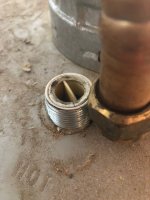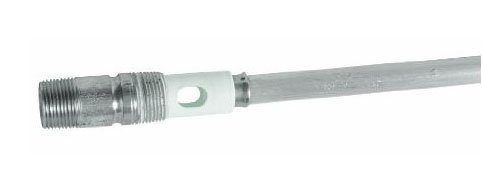Some comments/advice (although a bit late at this point)...
1. Who's the idiot engineer and/or bean-counter who thought it would be a good idea to combine the anode with the inlet nipple? And then made the nipple so short that you have to put a wrench on the nipple threads. I'm glad I now know of this design so I will be on the lookout to AVOID these types of water heaters when shopping for one in the future.
2. An anode rod that has been in service for any length of time will have pitting and corrosion. That's not a measure of its remaining life. Also, the white deposits on it are mostly the oxide deposits that form as the anode does its job. Again, it's normal. What you need to inspect for is how much of the anode metal is remaining. But in this case, the point is academic as you can't reuse these stupid combination anode/nipples.
3. Just to be clear, the tapered threads on water pipe (together with appropriate sealant) are what create the watertight seal that keeps the water inside the pipe. Two problems with wrenching on the threads: (1) You WILL damage those threads. (2) You risk warping the nipple (especially at the threads as that is where the pipe walls are the thinnest). Even if you do not visibly crush the nipple, if the pipe is just slightly out-of-round at the threads, you will not have a good seal. Even applying copious amounts of Teflon tape or pipe dope will not be a long-term solution (although you can get away with a short-term emergency fix, as you discovered). In summary, I would never put a nipple or pipe back into permanent service once a wrench has been used on the threads.
4. You really should have cleaned your work are before you started this job. Not only is your supply pipe sitting in that mess of dust and construction debris on the top of your heater, but I'm certain some of that crap got knocked into your heater after the nipple was removed. In America, we tend to take clean potable water for granted because it's ubiquitous in our civilized society. But we should be diligent to keep it that way. Not only is it nasty to drink water contaminated with dirt, sawdust, gypsum, etc., but a water heater can provide an excellent environment for growing bacteria. Dusting off the top of the heater would have taken less than a minute, and wiping it down with a sanitizing solution (like a Clorox wet wipe) would have been even better.
5. For the same reason, it was a bad idea to spray WD-40, or any other toxic solvents, onto your nipple. A pipe nipple achieves its seal by compressing the tapered male threads into the tapered female threaded socket. The force required to break them free is the torque needed to overcome that metal-on-metal compression (plus any bonding effect that may be present from the possible application of setting thread sealants). Penetrating oil will never get down deep enough into the threads to help. (Think about it: the threads are designed to make a seal against even the smallest fluid leakage, so they will seal against the penetrating oil on the outside of the pipe as effectively as they do against the water on the inside of the pipe.) And unlike straight threads (like on a bolt), once you break the seal on the nipple, it comes out easily because the threads are tapered and the clearance between the male and female threads increases with each degree of rotation. So the only thing you're doing by applying penetrating oil to your nipple is risking the contamination of your potable water. Note: If your nipple threads are rusted together, then that means they were never properly sealed in the first place and the male and female threads are now corroded JUNK and both will need replacement.
6. There is a drain at the bottom of your water heater. You should put a hose on it and flush out your heater every 6 to 12 months. But especially after doing any work on the heater (or upstream piping). Don't try to flush out your heater by opening a faucet or even a bathtub spigot. In fact, most of the crap that fell into your heater during your anode replacement is still sitting in the bottom of your heater. So go put that drain to good use. But be cautious: many heaters these days have cheap plastic hose spigots for drains and you do not want to put too much force on them when opening/closing and you definitely do not want to pull on the hose when it's attached.


